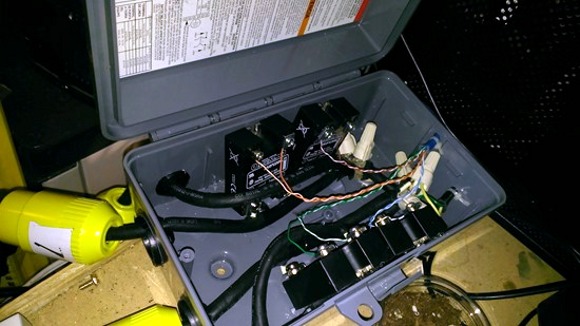
[The Cheap Vegetable Gardener] assembled his first grow controller about three and a half years ago. He’s been very happy with it and knows that he’ll be using it for years, maybe even decades to come. He just finished overhauling the grow controller design to help make sure he doesn’t burn down his garage one day. You have to admit, without knowing anything about the project this rendition does look safer than his original offering.
Pictured above is the weather-proof enclosure he used to house four mains-rated solid state relays. This box is isolated from the control hardware, providing heavy-duty utility plugs to interface with the heater, lights, fan, and water pump. He mounted the Arduino board which controls the relays to the outside of the box, using the Ethernet wire to switch the SSRs. It uses a manufactured shield he designed which will help ease the pain of fixing the system if parts ever go bad.
Later on in the build he shows the grow light and heaters used in his operation. The heaters simply screw into light sockets; something we’ve never come across before.















inb4 “not vegetables”
yes, actual vegetables.
inb4 “bowl of pot bottom right”
Wow, looks like a great job of originality to make plants grow more effectively on their own. Good job, Cheap Vegetable Gardener!
http://www.quickmeme.com/meme/3u9r9h/
What’s the point of dealing with mains/SSRs yourself as opposed to buying UL-tested controllable mains switches? I know that off-the-shelf isn’t much of a hack, but the real novel parts seems to be the sensors and control software, not the mains-exposed hardware. Unless you are qualified to be mucking with mains directly, why risk it for a hobby project?
Looks like he’s got the household-voltage stuff under control. Wiring up a switch (or relay) really isn’t that big of a deal for anyone who knows how to turn off a breaker. And it’s all in one nice, neat box this way.
Certainly less dangerous than the concept of indoor gardening in general, which can totally wreck your front door, just for starters . . . cf http://www.kansascity.com/2013/05/03/4217089/records-leawood-drug-raid-based.html
Also worth noting that many of the commercial versions use mechanical relays for cost savings which should fail much sooner than SSR. My secondary reason was cost given I can buy a SSR for $5-10 versus $20-30+ for a UL-tested component.
Though I do agree if you are not comfortable dealing with high voltage I would definitely recommend going with a commercial solution like the CatTail (if they still make these)
I haven’t seen the specs for this yet, and maybe I shouldn’t be commenting when I haven’t read everything, but being ill-prepared has never stopped me before. :) I just wanted to point out that the SSRs that I see in that image are single-pole. Since I keep seeing the term ‘mains’ for power, I’m assuming this is running in Europe somewhere on 220V, which would imply that it’s not split-phase, which in turn means that you’re only stopping half the supply to the device. This works, but it leaves the device in a state where it’s ‘off’ but can still shock someone who messes with it. Yes, if they have a brain they will unplug the device before messing with it, but it’s Good Practise to interrupt both sides of a full-phase feed. Just sayin’.
Secondly, those SSRs don’t have heat sinks. Did you check to make sure they can handle the full amperage without heat sinks? The heat sinks are sold separately….
Mike
Just because 220 VAC in the USA is “split-phase” doesn’t mean that in other countries it is obtained that way. I too may be ill-prepared to state the following, but I believe “their” 220 VAC is single phase, just like “our” 120 VAC is single phase. The 220 VAC we use at work (here in the USA) for testing the products we send to “there” is 60Hz as opposed to “their” 50Hz, but the difference doesn’t seem to bother my bosses or the customers.
First off, thanks Mike for mentioning my project. These are a pair of simple 150 watt ceramic heaters you can pick up online or your local pet store (typically used for aquariums for animals like lizards)
Hit post too soon…also want to thank the HackaDay readers since many of the improvements I made on this project was directly from feedback many of you gave me after the last time I shared this out.
Hey,
I have been having great success with my own indoor gardening and I don’t really want to spend $800 on a good controller, I may attempt to automate some of my room based on your design. May I ask more about your “Custom Software” with the graphs and ll that?
thanks
dALE
Shoot me a mail on the Contact page on my site, would be happy to answer some questions.
Since the wattage is kinda low I am not too concerned about heat dissipation on those SSR’s On the next rev you might want to consider adding heatsinks for them. If you plan on driving any larger loads.
Yes, adding heat sinks is on the short list, less for heat given at most I hit 2 amps on a circuit and they are rated at 20…cool to touch (after disconnecting power of course) The addition of these would be to more securely attach the SSRs to the side…
cf. https://www.google.com/webhp?q=Screw-in%20Infrared%20Heater%20Bulbs#q=Screw-in+Infrared+Heater+Bulbs&source=univ&tbm=shop